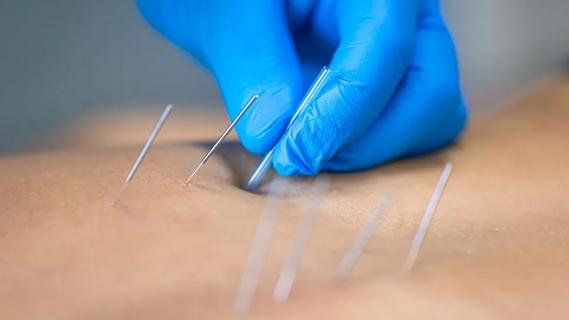Using alternative modalities to help patients with post-surgical pain

In the wake of the opioid crisis and the over-reliance on opioids for postoperative pain, pain management specialists at Cleveland Clinic have been working with their surgical and nursing colleagues to develop pathways with a more judicious use of narcotics and the use of alternative modalities.
Advertisement
Cleveland Clinic is a non-profit academic medical center. Advertising on our site helps support our mission. We do not endorse non-Cleveland Clinic products or services. Policy
An important example of this work can be found in the opioid-sparing protocol developed for patients undergoing implementation of a left ventricular assist device (LVAD) for advanced heart failure. It was put together by Richard W. Rosenquist, MD, Chairman of the Department of Pain Management, and Xavier Jimenez, MD, of the Chronic Pain Rehabilitation Program, in collaboration with critical care nurse Kimberly Miracle, NP, and senior social worker Kay Kendall, LISW, of the Sydell and Arnold Miller Family Heart & Vascular Institute.
The protocol shows that an opioid-sparing approach can work for patients who’ve undergone a major open-heart procedure. Guidelines require heart transplant patients to be opioid-free, so the regimen impacts transplant eligibility as well as overall health.
“An opioid-sparing strategy in this subset of patients is definitely new,” Dr. Rosenquist says. “About 90% of these patients — most of whom were opioid naïve — were leaving the hospital taking opioids, and a significant number were still taking them a year later.”
Since the protocol’s introduction in 2016, only a limited number of LVAD patients leave the hospital on a continued opioid and the overwhelming majority of those who do are off within two weeks; and the percentage of patients still on opioids after one year has dropped to approximately 10%. An 18-month follow up of the population’s Ohio Automated Rx Reporting System (OARRS) reports shows a sustained decrease in opioid usage following hospitalization.
Advertisement
The work began in 2015 when Miracle and Kendall observed that some of the LVAD patients returning for follow-up care a year or two after surgery were using daily opioids.
“Pain management in our LVAD patients was just not being talked about on any level, and there was nothing in the literature,” Miracle says. Previously, the majority of postoperative LVAD patients were discharged with self-directed opioid prescriptions and advised to follow up with their physician of preference for ongoing pain management, if needed. Miracle’s review of LVAD patient charts and OARRS reports showed that 30% of the LVAD population at that time were receiving a chronic opioid, although few patients were being managed by a chronic pain specialist.
Miracle and Kendall approached Dr. Jimenez for support, with Dr. Rosenquist soon joining. Meetings ultimately led to a unified opioid-sparing protocol that focuses on preoperative education and setting realistic expectations about pain following an LVAD procedure.
“A big part of pain is the fear associated with it,” says Dr. Rosenquist. “Teaching patients before surgery that some pain is to be expected following a major surgery helps to reduce pain because patients become less afraid of what is happening to them.”
The protocol begins tapering opioids soon after arrival from the intensive care unit to the regular nursing floor and supplementing with non-opioid alternatives, including acetaminophen around-the-clock, lidocaine patches, and possibly gabapentin.
Advertisement
“Of course, the taper has to be individualized. However, if the opioid is tapered on a particular day, we will not increase the dose back the next; rather, we move forward by escalating non-opioid alternatives,” says Miracle.
LVAD mid-levels have daily conversations with patients about their pain; adjust non-opioid alternatives accordingly; and offer a full spectrum of other modalities as needed, including a heating pad, repositioning in bed, time out of bed, Reiki therapy or other relaxation techniques.
“When patients know that you are available and actively listening to their concerns, they accept that you are choosing a pain management path that will be safe and successful,” Miracle says.
“When we started this process, we thought we would need a toolbox of alternative medications. That isn’t the case. We’re using medications that we’ve been using for years, but we’re using them more,” she adds. Fewer than half of patients are discharged with gabapentin, and of those, about 70% go home with prescriptions for 900 mg or less daily.
After the protocol was introduced, “we were shocked that it didn’t take a lot more work,” Miracle says. “But it does take a conversation, and once you begin that conversation, patients get it.”
The team is currently completing an analysis of two years of data on approximately 200 patients. Preliminary data show that the protocol led to a significant reduction in the number of opioids prescribed by the LVAD care team while patients were hospitalized and comparable levels of pain control among patients who underwent LVAD surgery before and after the protocol’s introduction.
Advertisement
Kendall advises providers interested in implementing similar protocols to “persist, be educated, and consult with people who have implemented similar programs. It is difficult to talk about and change the management of pain, but this is a professional responsibility.
Advertisement
Advertisement

Staged pivotal noninferiority study is comparing BrioVAD with HeartMate 3

Cleveland Clinic series supports its feasibility, especially with HeartMate 3

Program enhances cooperation between traditional and non-pharmacologic care

Pain specialists can play a role in identifying surgical candidates

Clinical judgment is foundational to appropriately prescribing

The device is a less invasive alternative for patients who are struggle with chronic pain

The Four Pillar Project provides physicians with evidence-based talking points to quickly identify problem areas and educate patients to optimize important aspects of their health.

When conservative approaches don’t work, it may be time to turn to sacroplasty